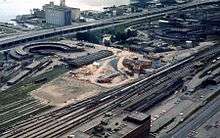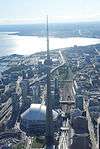Railway Lands

Railway Lands is an area in Downtown Toronto, Canada. The former Railway Lands was a large railway switching yard near the Toronto waterfront, including the CNR Spadina Roundhouse and the CPR John Roundhouse, but has since been redeveloped and today is home to mostly mixed-used development, including the CN Tower and the Rogers Centre. The lands were owned and maintained by the Canadian National Railway and later transferred to the federal crown corporation Canada Lands Company. The area is bounded by Front Street, Yonge Street, Gardiner Expressway and Bathurst Street.[1] The western portion of the Railway Lands is now part of the CityPlace neighbourhood and the eastern portion is now called South Core.
History
Early history
The first railway, Ontario, Simcoe and Huron (OS&H) arrived in Toronto in 1853 with a station located near the current Union Station. Rivals Grand Trunk Railway and Great Western Railway arrived in Toronto to compete with OS&H. The competition placed a strain on the new station and by 1873 a new Union Station was built by the GTR.[2] In the 1880s Grand Trunk Railway acquired rival railways (GWR in 1882 and OS&H in 1888) and the Canadian Pacific Railway arrived in the city in 1888. The competition soon meant the second station was strained as well and by 1900 there was a need for a newer station.[2] Delays on this station resulted in the third Union Station not opening until 1927,[2] by which time the GTR was merged into the Canadian National Railway (1923).
From the 1850s to 1920s the area south of the railway lands were filled in to accommodate railway needs. From 1858 onwards the railway expanded in area as the first Union Station was built.[3] From the 1850s to 1920s, the area south of Front Street was filled in to provide more room for railways, industrial growth and harbour needs.[4]
Redevelopment

1960s–1980s
Going as far back as 1965, when CN began to shift the functions of many of its yards in the Greater Toronto Area to a centralized facility in the northern suburb of Vaughan, the railways lands were made redundant. The area was then slated for re-development for post-railway beginning with plans for the building of a communications tower (the CN Tower) and the massive Metro Centre. Two years into the construction of the CN Tower, plans for Metro Centre were scrapped, leaving the tower isolated on the Railway Lands in what was then a largely abandoned light-industrial space. Development of the Railway Lands slowed down between the 1970s to 1980.[5] The early 1980s saw more redevelopment, with the opening of the Metro Convention Centre in 1984. The late 1980s saw the building of the SkyDome (for which the CNR Spadina Roundhouse was demolished) and the SkyWalk connecting the SkyDome with Union Station.


1990s–2000s
In the early 1990s redevelopment slowed, but it did see the expansion of the convention centre and the John Street Roundhouse redeveloped into the Roundhouse Park, though it would not be restored until the 2000s. It also saw the building of the Air Canada Centre in the late 1990s along the eastern boundary of the Railway Lands.
In the early 21st Century, the remaining area began to change rapidly with residential and then commercial development changing the area's past use. The western portion of the Railway Lands, defined by the city as Railway Lands West,[1] is today home to the CityPlace neighbourhood built just west of Spadina Avenue, south of Front Street and north of the Gardiner Expressway. Railway Lands Central[1] is mixed use land slightly east of Spadina to the area east of the CN Tower is home to Rogers Centre and CN Tower and parts of CityPlace. Railway Lands East[1] is now the South Core neighbourhood and is a mixed used land slightly east of Rogers Centre and is home to Union Station (and Union Station Bus Terminal), Dominion Public Building, SkyWalk, Metro Toronto Convention Centre, Roundhouse Park, Steam Whistle Brewing, Southcore Financial Centre, Delta Hotel Toronto, Maple Leaf Square and Air Canada Centre.
On August 3, 2016, Mayor John Tory announced a proposal to create a Rail Deck Park, decking over the Railway Lands West section to provide additional parkland in Downtown Toronto. The proposed greenspace would comprise 8.3 hactares.[6]
The only remaining rail connection is the Union Station Rail Corridor, which is maintained by Toronto Terminals Railway and consists of the narrow area used by tracks leading into and out of Union Station. The SkyWalk transverses a large part of the former Railway Lands, connecting Union Station with the lands south of the rail corridor.
Gallery
- The eastern portion of the Railway Lands, prior to most of the redevelopment, except for the ACC (at top) and a condo under construction (at bottom)
See also
- Old Canadian National rail yard, a similar redevelopment in Edmonton
References
- 1 2 3 4 http://www.toronto.ca/planning/urbdesign/pdf/29railwaylands_wescen_pt1.pdf
- 1 2 3 Toronto Railway Historical Association. Trha.ca (1927-08-10). Retrieved on 2013-07-26.
- ↑ Toronto Railway Historical Association. Trha.ca. Retrieved on 2013-07-26.
- ↑ City of Toronto, History Resources. Toronto.ca (2000-10-23). Retrieved on 2013-07-26.
- ↑ A visual history of the Toronto Railway Lands. Blogto.com (2011-11-03). Retrieved on 2013-07-26.
- ↑ Simmons, Taylor (August 3, 2016). "Massive downtown #RailDeckPark will cover railway tracks from Rogers Centre to Bathurst". CBC News. Retrieved November 11, 2016.
External links
| Wikimedia Commons has media related to Railway Lands. |
- Simulation of the history of the Railway Lands
- A visual history of the Toronto Railway Lands, BlogTO
- A visual construction history of the CN Tower - at 40th year anniversaries
 |
Financial District |  | ||
| CityPlace | |
South Core | ||
| ||||
| | ||||
| Harbourfront |
Coordinates: 43°38′41″N 79°22′51″W / 43.644662°N 79.380770°W